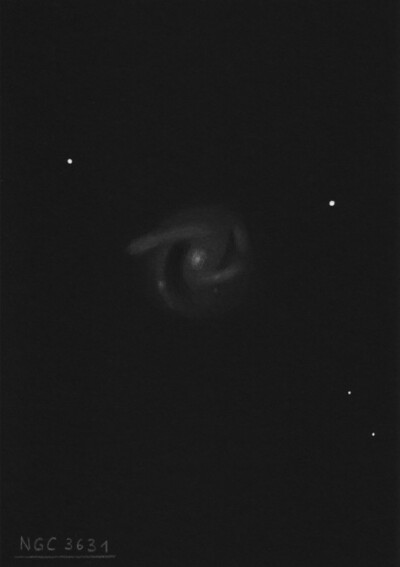
William Herschel discovered NGC 3631 = I-226 on 14 Apr 1789 (sweep 920) and recorded "cB, R, small br nucl and vF halo of considerable extent, 3' or 4' dia."
Four observations describing spiral arms were made at Birr Castle. On 30 Mar 1856, R.J. Mitchell recorded "Spiral, with I think, two arms thus (thumbnail sketch). The arms are broken and of unequal light. There are bright patches at alpha (preceding the nucleus), beta (south preceding arm) and gamma (end of bright north following arm)." A week later he logged "Spirality seen as in last observation. The following branch comes down past the other, doubling over it and seems to originate from the preceeding side of nucleus. Very patchy."
The1880 publication has a thumbnail sketch and the 1861 publication has a drawing (Plate XXVII, fig 20). Both show the main features that can be confirmed on the DSS.
400/500mm - 17.5" (4/1/95): bright, large, round, 3.5' diameter. Sharp concentration with a prominent core which brightens to a nearly stellar nucleus. The outer halo fades into the background and shows a hint of the spiral arm structure. Two mag 12-13 stars are 3.4' NE and 3.3' WNW of center.
900/1200mm - 48" (4/4/11): beautiful face-on spiral of 4' diameter with two long, winding arms and branching extensions! This very bright galaxy appeared sharply concentrated with an intensely bright small core that increased to an extremely bright stellar nucleus. A prominent patchy arm was attached on the west side of the core and rotated counterclockwise to the north, then bent sharply back in a straight line to the east end of the galaxy. What appeared to be an offshoot arm turned counterclockwise on the east side and continued all the way to the south end of the galaxy. The second arm was attached on the southeast end of the core and swept around the south side towards the west and then continued to the northwest end of the galaxy. An offshoot or another patchy arm continued east near the edge of the northern halo. The two main arms are nearly connected by a slightly brighter region on the south side. Member of the LGG 241 or UMa NED1 Group.
Notes by Steve Gottlieb